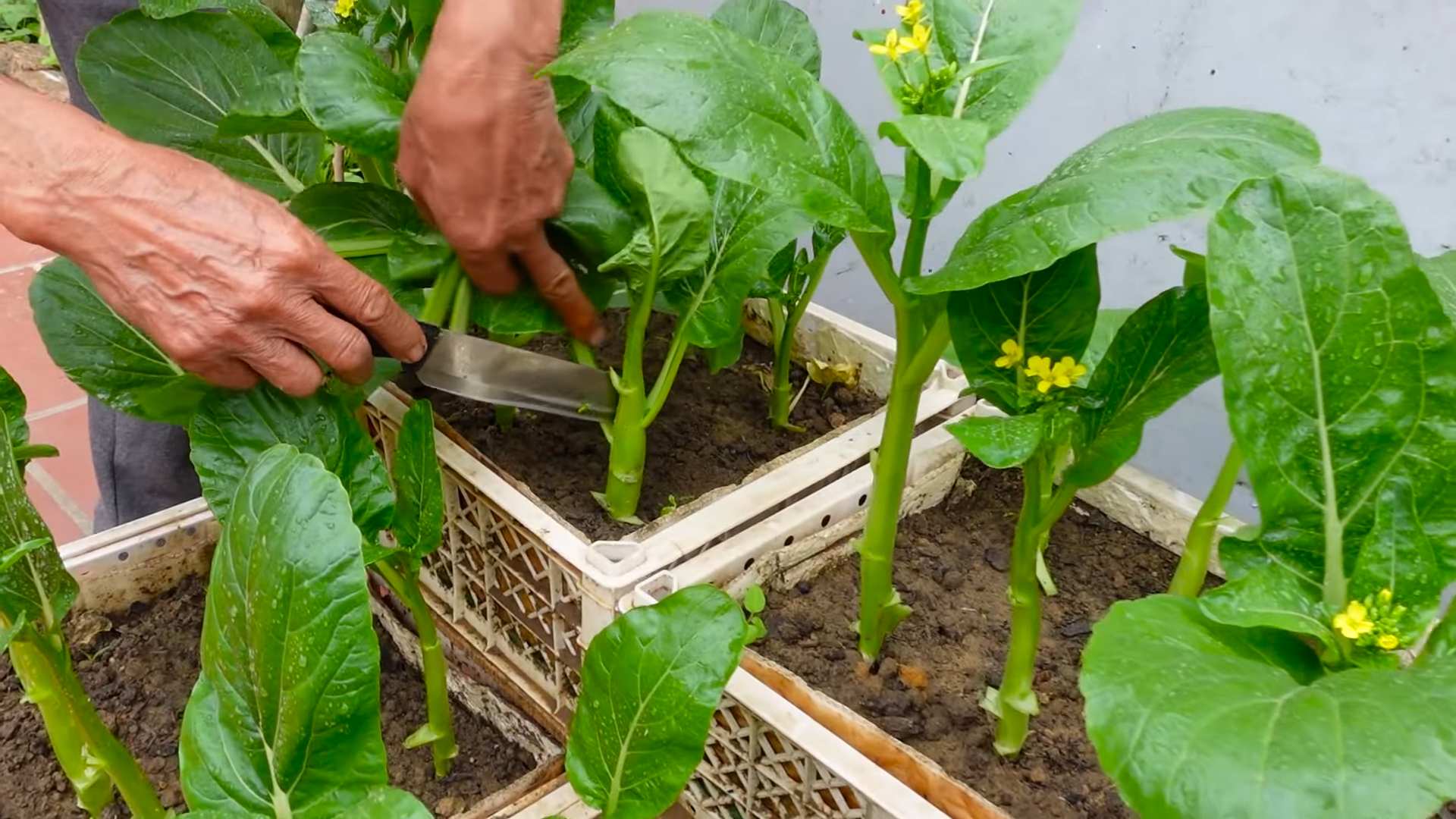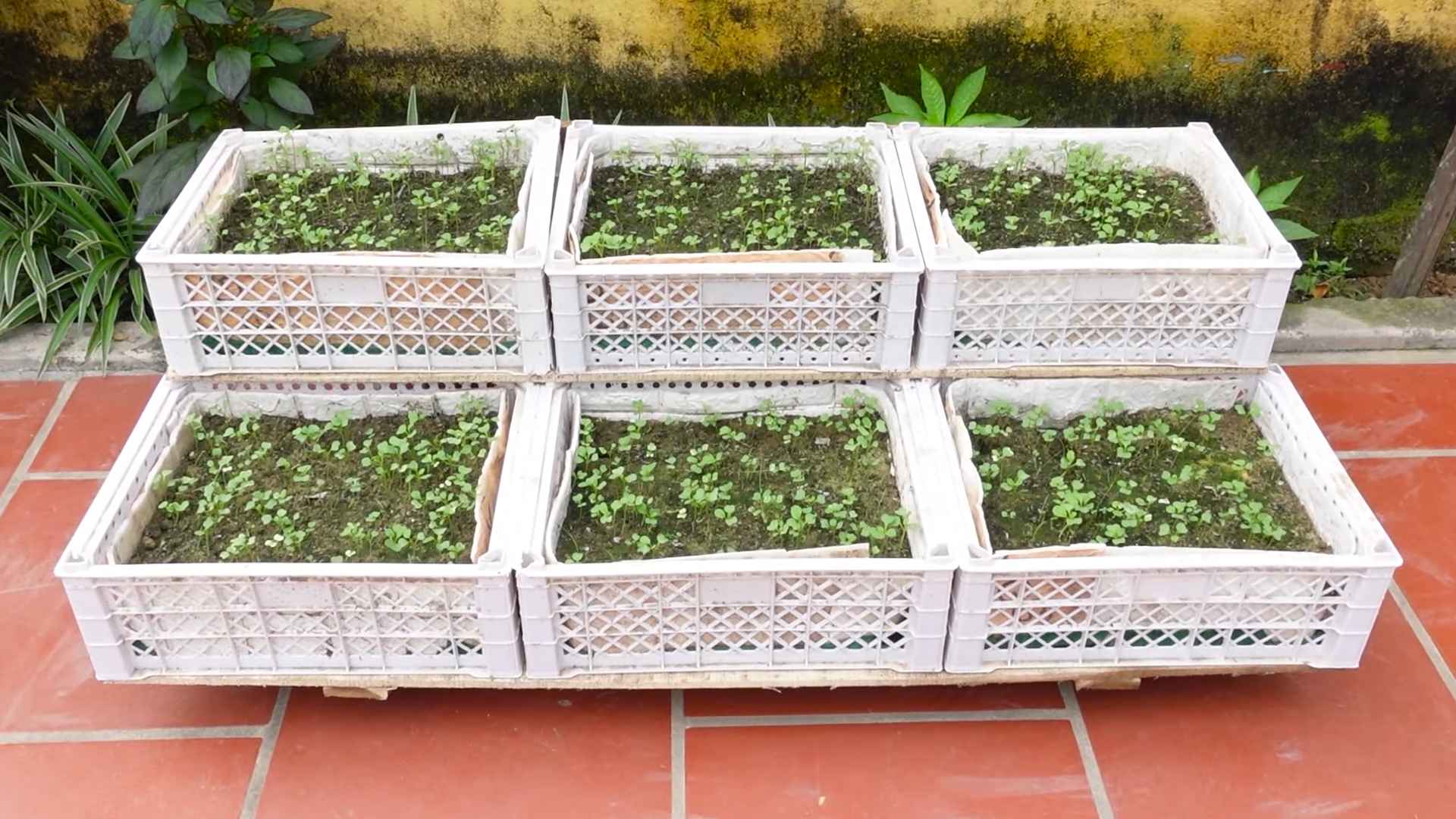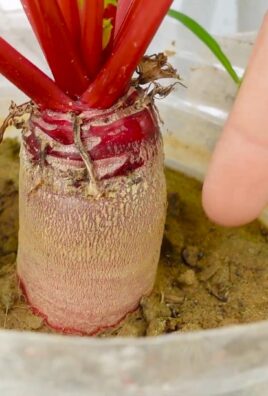Growing Chinese Cabbage might seem intimidating, but trust me, it’s a rewarding experience that brings fresh, crisp greens right to your kitchen! Have you ever dreamt of strolling through your own backyard, snipping off the perfect head of Chinese cabbage for a stir-fry or a vibrant salad? This DIY guide will turn that dream into a delicious reality.
Chinese cabbage, also known as Napa cabbage, has a rich history deeply rooted in Asian cuisine. Cultivated for centuries, it’s a staple ingredient in dishes like kimchi and stir-fries, offering a unique flavor and satisfying crunch. But you don’t need to travel to Asia to enjoy this versatile vegetable.
Why should you try growing Chinese Cabbage yourself? Well, store-bought options often lack the freshness and flavor of homegrown produce. Plus, you’ll have complete control over the growing process, ensuring your cabbage is free from harmful pesticides and chemicals. In this article, I’ll share my favorite DIY tricks and hacks to help you cultivate a thriving Chinese cabbage garden, even if you’re a complete beginner. Get ready to roll up your sleeves and discover the joy of harvesting your own delicious, healthy Chinese cabbage!

Growing Chinese Cabbage: A DIY Guide for a Bountiful Harvest
Hey there, fellow gardening enthusiasts! I’m so excited to share my tried-and-true method for growing delicious and crisp Chinese cabbage right in your own backyard. It’s easier than you might think, and the reward of fresh, homegrown veggies is totally worth it. Let’s dive in!
Choosing the Right Variety and Timing
Before we get our hands dirty, it’s crucial to pick the right Chinese cabbage variety and plant it at the optimal time. This will significantly impact your success.
* Variety Selection: There are two main types of Chinese cabbage: Napa cabbage (also known as Michihili) and Bok Choy. Napa cabbage forms a tight, oblong head, while Bok Choy has loose, leafy stalks. I personally love Napa cabbage for its versatility in salads and stir-fries, but Bok Choy is equally delicious and easier to grow in some climates. Consider your local climate and personal preferences when choosing. Some popular Napa varieties include ‘Blues’, ‘China Pride’, and ‘Wong Bok’. For Bok Choy, ‘Mei Qing Choi’ and ‘Joi Choi’ are excellent choices.
* Timing is Everything: Chinese cabbage is a cool-season crop, meaning it thrives in cooler temperatures. Planting at the wrong time can lead to bolting (premature flowering), which makes the cabbage bitter and inedible. The ideal planting times are late summer for a fall harvest or early spring for a late spring/early summer harvest. I usually aim to plant my fall crop about 6-8 weeks before the first expected frost. For a spring crop, start seeds indoors about 4-6 weeks before the last expected frost.
Preparing the Soil: The Foundation for Success
Chinese cabbage needs nutrient-rich, well-draining soil to flourish. Proper soil preparation is key to a healthy and productive crop.
* Soil Testing: Before you do anything, it’s a good idea to test your soil’s pH. Chinese cabbage prefers a slightly acidic to neutral pH of 6.0 to 7.5. You can purchase a soil testing kit at most garden centers or send a sample to your local agricultural extension office.
* Amending the Soil: Based on your soil test results, you’ll need to amend the soil accordingly. If your soil is too acidic, add lime to raise the pH. If it’s too alkaline, add sulfur to lower it. Regardless of your soil’s pH, I always recommend adding plenty of organic matter, such as compost or well-rotted manure. This will improve drainage, aeration, and nutrient content.
* Tilling or Digging: Once you’ve amended the soil, till or dig it to a depth of at least 12 inches. This will loosen the soil and make it easier for the cabbage roots to penetrate. Remove any rocks, weeds, or other debris.
* Creating Raised Beds (Optional): I personally prefer growing Chinese cabbage in raised beds. They provide excellent drainage and warm up faster in the spring. If you choose to create raised beds, make them about 6-8 inches high and 3-4 feet wide.
Starting Seeds Indoors (Optional)
Starting seeds indoors gives you a head start on the growing season, especially if you live in a region with a short growing season.
* Choosing Seed Starting Trays or Pots: Use seed starting trays or small pots filled with a seed starting mix. Avoid using garden soil, as it can be too heavy and may contain pathogens.
* Sowing the Seeds: Sow the seeds about ¼ inch deep and gently water them. Keep the soil consistently moist but not waterlogged.
* Providing Light and Warmth: Place the trays or pots in a warm location with plenty of light. A sunny windowsill or a grow light works well. The ideal temperature for germination is around 70-75°F (21-24°C).
* Hardening Off: Once the seedlings have developed a few true leaves, it’s time to harden them off. This process gradually acclimates the seedlings to outdoor conditions. Start by placing them outside for a few hours each day, gradually increasing the amount of time they spend outdoors over the course of a week.
Transplanting Seedlings or Direct Sowing
Whether you started seeds indoors or plan to direct sow, here’s how to get your Chinese cabbage into the ground.
* Spacing: Space Napa cabbage plants about 12-18 inches apart in rows that are 24-30 inches apart. Bok Choy can be spaced closer together, about 8-12 inches apart.
* Transplanting: If you started seeds indoors, carefully transplant the seedlings into the prepared soil. Dig a hole slightly larger than the root ball and gently place the seedling in the hole. Backfill with soil and water thoroughly.
* Direct Sowing: If you’re direct sowing, sow the seeds about ½ inch deep and cover them with soil. Water gently and keep the soil consistently moist until the seedlings emerge. Once the seedlings are a few inches tall, thin them to the appropriate spacing.
Caring for Your Chinese Cabbage
Once your Chinese cabbage is in the ground, it’s important to provide proper care to ensure a healthy and productive harvest.
* Watering: Chinese cabbage needs consistent moisture, especially during hot, dry weather. Water deeply and regularly, aiming for about 1 inch of water per week. Avoid overhead watering, as this can promote fungal diseases. Drip irrigation is an excellent option.
* Fertilizing: Fertilize your Chinese cabbage every 2-3 weeks with a balanced fertilizer. I like to use a liquid fertilizer diluted to half strength. You can also side-dress with compost or well-rotted manure.
* Weed Control: Keep the area around your Chinese cabbage free of weeds. Weeds compete with the cabbage for nutrients and water. Hand-pulling weeds is the best option, but you can also use a hoe or cultivator. Be careful not to damage the cabbage roots.
* Pest and Disease Control: Chinese cabbage is susceptible to several pests and diseases, including aphids, cabbage worms, and clubroot. Regularly inspect your plants for signs of infestation or disease.
* Aphids: These tiny insects suck the sap from plants, causing them to wilt and yellow. You can control aphids with insecticidal soap or neem oil.
* Cabbage Worms: These caterpillars feed on the leaves of cabbage plants, leaving behind holes. You can control cabbage worms with Bacillus thuringiensis (Bt), a natural insecticide.
* Clubroot: This fungal disease causes the roots of cabbage plants to swell and become distorted. To prevent clubroot, plant resistant varieties and practice crop rotation.
* Mulching: Apply a layer of mulch around your Chinese cabbage plants. Mulch helps to retain moisture, suppress weeds, and regulate soil temperature. Straw, wood chips, or shredded leaves are all good options.
Harvesting Your Bounty
The moment you’ve been waiting for! Knowing when and how to harvest your Chinese cabbage is essential for enjoying its peak flavor and texture.
* When to Harvest: Napa cabbage is ready to harvest when the head is firm and compact, usually about 70-80 days after planting. Bok Choy can be harvested earlier, when the leaves are about 12 inches long.
* How to Harvest: To harvest Napa cabbage, use a sharp knife to cut the head off at the base. For Bok Choy, you can harvest the entire plant or just the outer leaves.
* Storage: Store harvested Chinese cabbage in the refrigerator. Napa cabbage can be stored for several weeks, while Bok Choy is best used within a few days.
Troubleshooting Common Problems
Even with the best care, you might encounter some challenges along the way. Here are a few common problems and how to address them:
* Bolting: As mentioned earlier, bolting is premature flowering. It’s usually caused by hot weather or stress. To prevent bolting, plant at the right time and provide consistent moisture. If your cabbage starts to bolt, harvest it immediately.
* Slugs and Snails: These pests can damage the leaves of Chinese cabbage. You can control them with slug bait or by hand-picking them off the plants.
* Yellowing Leaves: Yellowing leaves can be a sign of nutrient deficiency or disease. Make sure your soil is properly amended and that your plants are getting enough water. If you suspect a disease, consult your local agricultural extension office for advice.
Enjoying Your Homegrown Chinese Cabbage
Congratulations! You’ve successfully grown your own Chinese cabbage. Now it’s time to enjoy the fruits (or rather, vegetables) of your labor.
* Culinary Uses: Chinese cabbage is incredibly versatile in the kitchen. You can use it in salads, stir-fries, soups, and slaws. It’s also a key ingredient in kimchi.
* Nutritional Benefits: Chinese cabbage is a good source of vitamins A and C, as well as fiber and antioxidants.
I hope this guide has inspired you to try growing

Conclusion
So, there you have it – a simple yet incredibly effective DIY trick to boost your Chinese cabbage harvest! We’ve walked through the steps, highlighted the benefits, and hopefully, inspired you to give it a try. But why is this method a must-try? Because it addresses some of the most common challenges faced when growing Chinese cabbage: bolting, pest infestations, and nutrient deficiencies. By implementing this DIY approach, you’re not just growing cabbage; you’re cultivating a healthier, more resilient, and ultimately, more abundant crop.
Think of it this way: store-bought Chinese cabbage, while convenient, often lacks the vibrant flavor and crisp texture of homegrown varieties. Plus, you have no control over the pesticides or fertilizers used in its cultivation. With this DIY trick, you’re taking charge of your food source, ensuring a fresh, healthy, and delicious addition to your meals.
But the beauty of gardening lies in its adaptability. Feel free to experiment with variations to suit your specific needs and environment. For example, if you live in a particularly hot climate, consider using shade cloth in addition to the DIY trick to further protect your Chinese cabbage from bolting. You could also try different types of organic fertilizers or compost teas to provide your plants with the nutrients they need.
Another exciting variation involves companion planting. Consider planting marigolds or nasturtiums near your Chinese cabbage to deter pests naturally. These flowers not only add beauty to your garden but also act as a natural defense against unwanted insects. You could also intercrop with fast-growing radishes, which can help break up the soil and provide some shade for the cabbage seedlings.
Furthermore, don’t be afraid to experiment with different varieties of Chinese cabbage. Some varieties are more heat-tolerant than others, while others are more resistant to certain pests or diseases. By trying out different varieties, you can find the perfect one for your specific growing conditions.
The key is to observe your plants closely and adjust your approach as needed. Gardening is a learning process, and every season brings new challenges and opportunities. Don’t be discouraged if you encounter setbacks along the way. Instead, view them as learning experiences and use them to improve your gardening skills.
We’re confident that this DIY trick will make a significant difference in your Chinese cabbage growing endeavors. It’s a cost-effective, environmentally friendly, and ultimately rewarding way to ensure a bountiful harvest. So, grab your gardening tools, gather your materials, and get ready to experience the joy of growing your own delicious Chinese cabbage.
We’re eager to hear about your experiences! Did this DIY trick work for you? Did you try any variations? What challenges did you face, and how did you overcome them? Share your stories, tips, and photos in the comments below. Let’s create a community of passionate gardeners who are dedicated to growing healthy, delicious food. Your insights could inspire others and help them achieve their gardening goals. Remember, every gardener has something to contribute, and together, we can learn and grow. So, go ahead, give this DIY trick a try and let us know how it goes! Happy gardening! Let’s all grow some amazing Chinese cabbage!
Frequently Asked Questions (FAQ)
What exactly is “bolting” and why is it bad for Chinese cabbage?
Bolting is when a plant prematurely produces a flowering stem, usually in response to stress such as heat or lack of water. For Chinese cabbage, bolting makes the leaves bitter and tough, rendering them largely inedible. The plant shifts its energy from leaf production to seed production, which is not what we want when growing Chinese cabbage for consumption. Preventing bolting is crucial for a successful harvest.
How often should I water my Chinese cabbage after implementing this DIY trick?
Watering frequency depends on your climate and soil type. Generally, Chinese cabbage needs consistent moisture, especially during hot weather. Check the soil moisture by sticking your finger about an inch deep. If it feels dry, it’s time to water. Aim for deep watering, allowing the water to soak into the soil rather than just wetting the surface. Mulching around the plants can help retain moisture and reduce the need for frequent watering. During cooler periods, you can reduce the watering frequency.
What kind of fertilizer is best for Chinese cabbage, and how often should I fertilize?
Chinese cabbage is a heavy feeder, meaning it needs a good supply of nutrients to thrive. A balanced fertilizer with equal parts nitrogen, phosphorus, and potassium (e.g., 10-10-10) is a good starting point. You can also use organic fertilizers like compost, well-rotted manure, or bone meal. Apply fertilizer at planting time and then again every 2-3 weeks during the growing season. Follow the instructions on the fertilizer package for application rates. Avoid over-fertilizing, as this can lead to excessive leaf growth and make the plants more susceptible to pests and diseases.
My Chinese cabbage is being attacked by pests. What can I do?
Pests like aphids, cabbage worms, and slugs can be a problem for Chinese cabbage. Regularly inspect your plants for signs of infestation. For aphids, you can try spraying them off with a strong stream of water or using insecticidal soap. Cabbage worms can be handpicked or treated with Bacillus thuringiensis (Bt), a natural bacterium that is safe for humans and beneficial insects. Slugs can be controlled with beer traps or by spreading diatomaceous earth around the plants. Companion planting with marigolds or nasturtiums can also help deter pests.
How do I know when my Chinese cabbage is ready to harvest?
Chinese cabbage is typically ready to harvest in 60-80 days from planting. The heads should be firm and compact. To harvest, simply cut the head off at the base with a sharp knife. You can also harvest individual leaves as needed, but this will reduce the overall yield.
Can I grow Chinese cabbage in containers?
Yes, you can grow Chinese cabbage in containers, but you’ll need a large container (at least 12 inches in diameter) to accommodate the plant’s root system. Use a well-draining potting mix and fertilize regularly. Container-grown Chinese cabbage may need more frequent watering than plants grown in the ground.
What are some good companion plants for Chinese cabbage?
Good companion plants for Chinese cabbage include:
* Marigolds and nasturtiums: Deter pests.
* Radishes: Break up the soil and provide shade for seedlings.
* Dill: Attracts beneficial insects.
* Garlic and onions: Repel pests.
How can I prevent my Chinese cabbage from bolting?
Besides the DIY trick mentioned in the article, you can also prevent bolting by:
* Planting at the right time of year (early spring or late summer).
* Choosing bolt-resistant varieties.
* Providing consistent moisture.
* Shading the plants during hot weather.
* Avoiding stress to the plants.
Is Chinese cabbage the same as Napa cabbage?
Yes, Chinese cabbage and Napa cabbage are the same thing. Napa cabbage is the most common type of Chinese cabbage grown in North America.
Can I save seeds from my Chinese cabbage plants?
Saving seeds from Chinese cabbage can be tricky because it is a biennial plant, meaning it typically flowers and produces seeds in its second year. Also, Chinese cabbage can cross-pollinate with other members of the Brassica family, so you’ll need to isolate your plants to ensure true-to-type seeds. If you’re interested in seed saving, research the specific requirements for Chinese cabbage and be prepared to dedicate two growing seasons to the process.





Leave a Comment